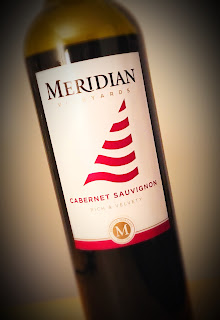Meridian Cabernet Sauvignon can be had at grocery stores, and for very little money - especially considering that it's California's premier grape, one that usually commands a premier price. On the label, where I expect to find the appellation listed, the words "rich and velvety" appear - so, no Napa, no Paso, no Sonoma. The winery lists its location as Livermore, one of the more unheralded of California's wine regions. There also is no vintage listed.
This Cabernet Sauvignon does not adhere to the practice of billboarding your high-class wine region front and center. In fact, the tech sheet for this wine gets no more specific about where the grapes were grown than "select vineyards in sun drenched California," which is at least a bit more helpful than "rich and velvety," although not much. The winery does have a good reputation, however, for presenting good quality wines at low prices - surprisingly low.
This Cab is unusual - by California standards, anyway - because part of it was vinified in stainless steel tanks instead of oak vats. The majority was fermented in oak and aged there for a mere six months instead of the customary year or two or three for Cabernets in the Golden State. Both factors allow the fruit to speak without the hand of oak covering its mouth. Two more things set the Meridian Cab apart from its top-shelf brethren - alcohol registers only 13% abv and the retail price sits at right around five bucks a bottle.
This wine shows a medium-dark ruby red color and a nose that is as pretty as they come. Cassis, strawberry, black cherry and clove make up the majority of the fragrances. Notable for their absence are darker, moodier notes like leather, forest floor or tobacco - this is a "happy Cab." The fruit comes first on the palate, too, with bright cherry and currant in the lead. The freshness of this Cab is amazing, and it delivers on the label's promise of "rich and velvety."
Follow Randy Fuller on Twitter

















